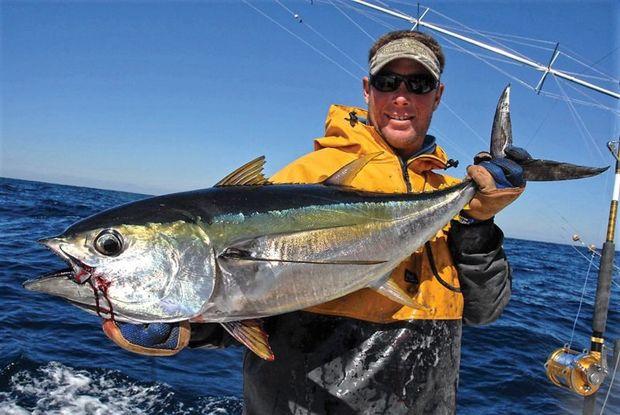Most people get their tuna out of a can, but those who catch their own get to enjoy these fish at their finest. When it comes to taste, there is no comparison between fresh or home canned tuna and the product on your grocery shelf.

So how does one go about catching a tuna? There are two ways: go on your own boat or on a charter boat. If you have a solid hull in the 22- to 25-foot range or even larger, you can go after tuna. If the boat can handle a steady diet of two- to three-foot waves along with the occasional five- to six-footer, it will do the job. The other consideration is fuel. You need enough to run out, troll all day, and then run back home times at least 1.5. If your calculations show you need 100 gallons to run out, troll, and run home you should carry at least 150 gallons.
While the canyons produce a lot of tuna, these fish are also found much closer to shore. Such locations as the Hot Dog, Massey’s Canyon, the Parking Lot, and the Cigar hold good numbers of tuna, especially during the early part of the season. As this is written in early May, boats out of Ocean City have already brought in yellowfin and bluefin tuna from the Rockpile and the Poorman’s Canyon. Temperature breaks over structure are the best bet for holding tuna.
I recall a trip out of Virginia Beach to the Cigar when the temperature break was as plain as the nose on your face. The cold water side was a sick gray color, while the warm water was blue and clear as glass. We trolled five lures, and every time we crossed from the cold to the warm side, we had five yellowfin tuna on the lines. There were five of us on the boat, so it didn’t take long to fill the three fish per person limit.
There is no reason to rig dead baits when targeting tuna. You can catch all you want on lures. Cedar plugs, Mold Crafts, Green Machines, and anything that smokes will bring strikes. I set two cedar plugs close to the transom just outside the prop wash. Two Mold Craft lures go on the riggers and are set on the second or third wake. The smoker or Green Machine go way back on the center rigger. You can handle most yellowfin and bluefin tuna with either 30- or 50-pound gear. Should you decide to try for bigeye tuna, you are going to need 80 to 130 outfits. If you hook a bigeye on 30-pound gear, you are going to be in for a long afternoon.
As a very general rule. the inshore tuna bite will begin with most boats trolling. As more boats decide to get in on the action, chumming will take over. Chumming will also produce in the canyons, but this is generally a nighttime operation. If you want to chum for tuna, you are going to need a lot of bunker or butterfish. Most captains will want at least three flats, so the money you save on fuel will be quickly eaten up by bait.
Try to anchor up on an edge. It is also helpful if you can mark fish or bait in the area. Once on station begin tossing over chunks of bunker, butterfish, or whatever you have for chum. Toss four or five pieces and then wait until they disappear before tossing over four or five more. Let your circle hook baited with a chunk of bunker go along with the chum. I rig my hooks with Fluorocarbon 60-pound leader, but may have to go down as low as 20-pound if the tuna become wary. Keep playing out line so that the bait falls naturally. You will feel the pickup. Let the tuna run for a few seconds, engage the reel, and when the line comes tight, the fish will be hooked.
You will need someone to gaff the tuna. Try to get the gaff behind the head, but any gaff job that puts a fish in the boat is a good one. You can avoid all this work by chartering a boat. Get five of your fishing friends to put up between $200 and $350 each, show up at the dock, sleep on the run out, crank in your tuna, sleep on the run back in, pick up your filets, and drive home.
by Eric Burnley